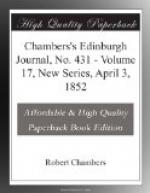The first of these groups of buildings is the Ponte a Serraglio. Here are the principal hotels; the post-office; the English reading-room and club; the Casino; a few small shops dignified by such names as ‘Magazine of Novelties,’ and ‘The Real Bazaar;’ and a caffe; where congregate all the idlers of the community.
About a mile further on, attainable by a pretty road, winding at the foot of a mountain bordered by acacia trees, and overhanging the river Serchio, is situated the Villa—another range of tenements, the inhabitants of which arrogate to themselves greater staidness of demeanour than their brethren at the Ponte, thinking, perhaps, that the vicinity of the English chapel—a handsome structure, in the style of an ancient Venetian palace—may vindicate this assumption of decorum. There is but one hotel at the Villa—calm, dignified, and frigid; the remainder of a long rambling street of which the place is composed, consists entirely of lodging-houses, having gardens attached to each, where little children may be seen playing at the doors, and English nurse-maids pursuing their laborious avocations. This preponderance of small children at the Villa, is as much its characteristic distinction, as whatever relates to gaiety, or novelty, or scandal, may be considered the peculiar attribute of the Ponte.
A distinct race inhabit the Bagni alla Villa—a group of houses inaccessible to carriages, rising on a hill behind the palace belonging to the ex-duke of Lucca. A fourth division of dwellings is the Bagni Caldi, the highest point of all, the occupants whereof have to descend as if from an eyrie, to gain any of the other localities. They are a set of whom little seems to be known—quaint and unsocial personages, venturing out at dusk like bats and owls, and looking grimly on all but their immediate neighbours: the gentlemen, mostly gouty, or otherwise disabled; the fairer sex, isolated and ancient, with a marked predilection for close straw-bonnets, large brown parasols, and blue veils.
Thus much for the first outline of the place and its frequenters. We must now take a glance at their pursuits and enjoyments.
The general tenor of a day at the baths is easily described. Till about five in the afternoon but few people venture out, although early in the morning it is said that some, more active than the rest, sally forth on their mountain rambles; but this deponent vouches not for their number or degree, never himself having had ocular demonstration of their movements. During the heat of the day, the greater part remain at home, excepting, indeed, the population of the Ponte, who, exulting in all the advantages their position unites, circulate from the post-office to the caffe, from the caffe to the club, and condole with such of the hapless denizens of the Villa and Bagni Caldi as a thirst for news and devouring ennui have driven to brave a hot summer walk to their more favoured region.




